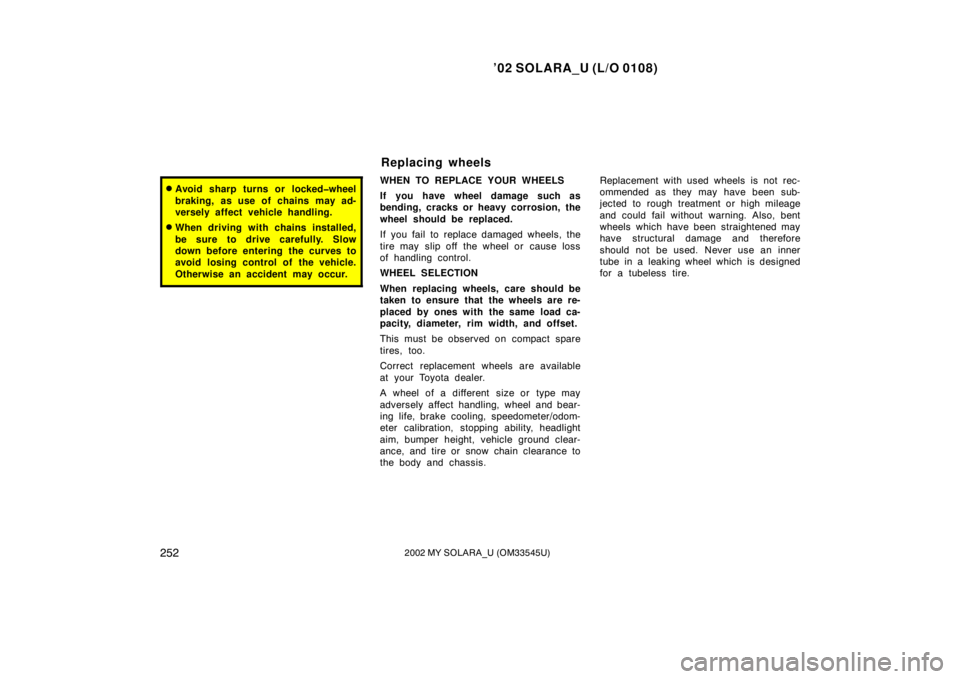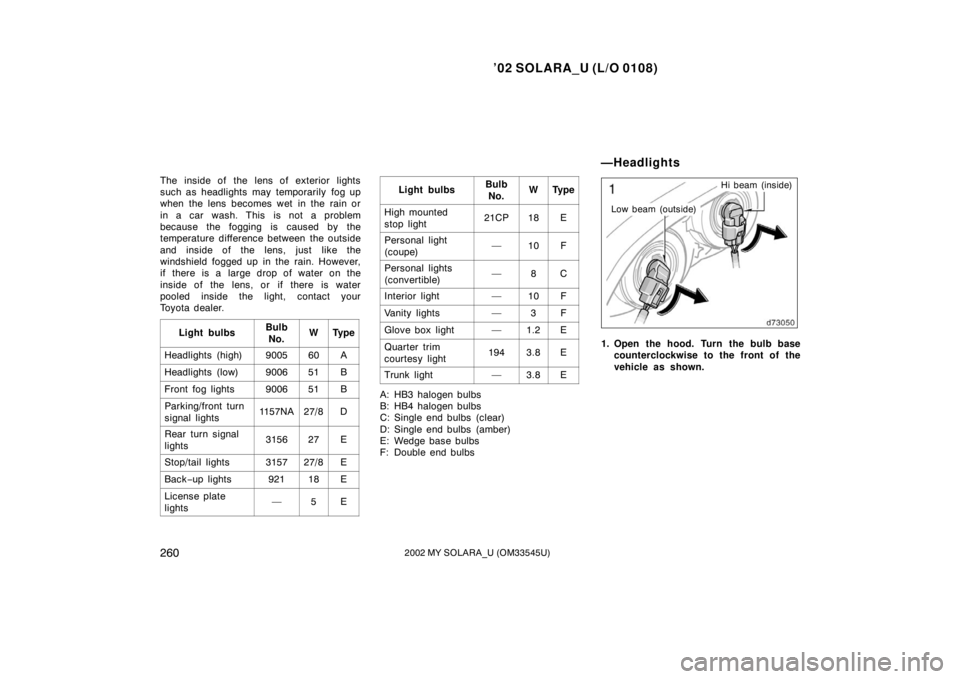Page 246 of 290

’02 SOLARA_U (L/O 0108)
2422002 MY SOLARA_U (OM33545U)
Front
Rear
When jacking up your vehicle with the
jack, position the jack correctly as
shown in the illustrations.
CAUTION
When jacking, be sure to observe the
following to reduce the possibility of
personal injury:
�Follow jacking instructions.
�Do not put any part of your body
under the vehicle supported by the
jack. Personal injury may occur.
�Do not start or run the engine while
your vehicle is supported by the
jack.
�Stop the vehicle on a level firm
ground, firmly set the parking brake
and put the transmission in “P”
(automatic) or reverse (manual).
Block the wheels on the opposite
side of the jack up point if neces-
sary.
�Make sure to set the jack properly
in the jack point. Raising the ve-
hicle with jack improperly posi-
tioned will damage the vehicle or
may allow the vehicle to fall off the
jack and cause personal injury.
�Never get under the vehicle when
the vehicle is supported by the jack
alone; use vehicle support stands.
�Do not raise the vehicle with some-
one in the vehicle.
�When raising the vehicle, do not
put an object on or under the jack.
NOTICE
Make sure to place the jack correctly,
or your vehicle may be damaged.
Positioning the jack
Page 252 of 290

’02 SOLARA_U (L/O 0108)
2482002 MY SOLARA_U (OM33545U)
Clean all dirt from outside of the reservoir
tank and look at the fluid level. If the fluid
is cold, the level should be in the “COLD”
range. Similarly, if it is hot, the fluid level
should be in the “HOT” range. If the level
is at the low side of either range, add
automatic transmission fluid DEXRON �II
or III to bring the level within the range.
To remove the reservoir cap, turn it coun-
terclockwise and lift up. To reinstall it,
turn it clockwise. After replacing the reser-
voir cap,visually check the steering box
case, vane pump and hose connections
for leaks or damage.
CAUTION
The reservoir tank may be hot so be
careful not to burn yourself.
NOTICE
Avoid overfilling, or the power steer-
ing could be damaged.
Keep your tire pressures at the proper
level.
The recommended cold tire pressures, tire
size and the vehicle capacity weight are
given in Section 8. They are also on the
tire pressure label as shown.
You should check the tire pressures every
two weeks, or at least once a month. And
don’t forget the spare!
Incorrect tire pressure can reduce tire
life and make your vehicle less safe to
drive. Low tire pressure results in excessive
wear, poor handling, reduced fuel econo-
my, and the possibility of blowouts from
overheated tires. Also, low tire pressure
can cause poor sealing of the tire bead.
If the tire pressure is excessively low,
there is the possibility of wheel deforma-
tion and/or tire separation.
High tire pressure produces a harsh ride,
handling problems,excessive wear at the
center of the tire tread, and a greater
possibility of tire damage from road haz-
ards.
If a tire frequently needs refi
lling, have it
checked by your Toyota dealer.
The following instructions for checking
tire pressure should be observed:
�The pressure should be checked only
when the tires are cold. If your ve-
hicle has been parked for at least 3
hours and has not been driven for
more than 1.5 km or 1 mile since, you
will get an accurate cold tire pressure
reading.
�Always use a tire pressure gauge.
The appearance of a tire can be mis-
leading. Besides, tire pressures that
are even just a few pounds off can
degrade ride and handling.
Checking tire pressure
Page 256 of 290

’02 SOLARA_U (L/O 0108)
2522002 MY SOLARA_U (OM33545U)
�Avoid sharp turns or locked�wheel
braking, as use of chains may ad-
versely affect vehicle handling.
�When driving with chains installed,
be sure to drive carefully. Slow
down before entering the curves to
avoid losing control of the vehicle.
Otherwise an accident may occur.
WHEN TO REPLACE YOUR WHEELS
If you have wheel damage such as
bending, cracks or heavy corrosion, the
wheel should be replaced.
If you fail to replace damaged wheels, the
tire may slip off the wheel or cause loss
of handling control.
WHEEL SELECTION
When replacing wheels, care should be
taken to ensure that the wheels are re-
placed by ones with the same load ca-
pacity, diameter, rim width, and offset.
This must be observed on compact spare
tires, too.
Correct replacement wheels are available
at your Toyota dealer.
A wheel of a different size or type may
adversely affect handling, wheel and bear-
ing life, brake cooling, speedometer/odom-
eter calibration, stopping ability, headlight
aim, bumper height, vehicle ground clear-
ance, and tire or snow chain clearance to
the body and chassis. Replacement with used wheels is not rec-
ommended as they may have been sub-
jected to rough treatment or high mileage
and could fail without warning. Also, bent
wheels which have been straightened may
have structural damage and therefore
should not be used. Never use an inner
tube in a leaking wheel which is designed
for a tubeless tire.
Replacing wheels
Page 264 of 290

’02 SOLARA_U (L/O 0108)
2602002 MY SOLARA_U (OM33545U)
The inside of the lens of exterior lights
such as headlights may temporarily fog up
when the lens becomes wet in the rain or
in a car wash. This is not a problem
because the fogging is caused by the
temperature difference between the outside
and inside of the lens, just like the
windshield fogged up in the rain. However,
if there is a large drop of water on the
inside of the lens, or if there is water
pooled inside the light, contact your
Toyota dealer.
Light bulbs
BulbNo.WTy p e
Headlights (high)900560A
Headlights (low)900651B
Front fog lights900651B
Parking/front turn
signal lights1157NA27/8D
Rear turn signal
lights315627E
Stop/tail lights315727/8E
Back −up lights92118E
License plate
lights—5E
Light bulbsBulb
No.WTy p e
High mounted
stop light21CP18E
Personal light
(coupe)—10F
Personal lights
(convertible)—8C
Interior light—10F
Vanity lights—3F
Glove box light—1.2E
Quarter trim
courtesy light1943.8E
Trunk light—3.8E
A: HB3 halogen bulbs
B: HB4 halogen bulbs
C: Single end bulbs (clear)
D: Single end bulbs (amber)
E: Wedge base bulbs
F: Double end bulbs
Low beam (outside) Hi beam (inside)
1. Open the hood. Turn the bulb base
counterclockwise to the front of the
vehicle as shown.
—Headlights
Page 265 of 290
’02 SOLARA_U (L/O 0108)
2612002 MY SOLARA_U (OM33545U)
2. Unplug the connector while depress-
ing the lock release.
If the connector is tight, wiggle it.3. Install a new bulb and connector into the mounting hole.
Aiming is not necessary after replacing
the bulb. When aiming adjustment is nec-
essary, contact your Toyota dealer.1. Remove the bolts, take out the en- gine under cover.
—Front fog lights
Page 266 of 290
’02 SOLARA_U (L/O 0108)
2622002 MY SOLARA_U (OM33545U)
2. Turn the bulb and remove it.3. Unplug the connector while depress-
ing the lock release.
If the connector is tight, wiggle it.4. Install a new bulb and the connector into the mounting hole by turning it
clockwise.
Page 276 of 290

’02 SOLARA_U (L/O 0108)
2722002 MY SOLARA_U (OM33545U)
COOLING SYSTEM
Total capacity, L (qt., Imp. qt.):
6.0 (6.3, 5.2)
Coolant type: “TOYOTA Long Life Coolant” or equiva-
lent
With ethylene− glycol type coolant for a
proper corrosion protection of aluminum
components
Do not use alcohol type antifreeze or
plain water alone.
BATTERY
Open voltage
∗ at 20 �C (68 �F):
12.6—12.8 V Fully charged
12.2—12.4 V Half charged
11.8—12.0 V Discharged
∗: Voltage that is checked 20 minutes af- ter the key is removed with all the
lights turned off
Charging rates: 5 A max.
CLUTCH
Pedal free play, mm (in.): 5—15 (0.2—0.6)
Fluid type: SAE J1703 or FMVSS No.116 DOT 3 MANUAL TRANSAXLE
Oil capacity, L (qt., Imp. qt.):
2AZ− FE engine 2.5 (2.6, 2.2)
1MZ −FE engine 4.2 (4.2, 3.7)
Oil type: Gear oil API GL −4 or GL −5
Recommended oil viscosity: SAE 75W −90
AUTOMATIC TRANSAXLE
Automatic transmission
Fluid capacity (drain and refill),
L (qt., Imp. qt.): 2AZ− FE engine Up to 3.9 (4.1, 3.4)
1MZ −FE engine Up to 4.75 (5.0, 4.2)
Fluid type:
2AZ− FE engine—
Automatic transmission fluid Type T −IV
Change automatic transmission fluid only
as necessary. Generally, it is necessary to change auto-
matic transmission fluid only if your ve-
hicle is driven under one of the Special
Operating Conditions listed in your “Toyota
Service Booklet” or “Toyota Warranty
Booklet”. When changing the automatic
transmission fluid, use only Toyota Genu-
ine ATF Type T
−IV (ATF JWS3309 or
NWS6500) to aid in assuring optimum
transaxle performance.
Notice: Using automatic transmission
fluid other than Toyota Genuine ATF
Type T�IV may cause deterioration in
shift quality, locking up of your trans-
mission accompanied by vibration, and
ultimately damage the automatic trans-
mission of your vehicle.
1MZ −FE engine—
Automatic transmission fluid D −ll or
DEXRON �III (DEXRON �II)
Page 280 of 290

’02 SOLARA_U (L/O 0108)
2762002 MY SOLARA_U (OM33545U)
Engine compartment (type B)
13. HEAD LH(UPR): Left−hand headlight
(high beam)
14. RADIO NO.1 20 A: Audio system
15. DOME 7.5 A: Theft deterrent system,
daytime running light system, clock,
locking with wireless remote control
system, ignition switch light, pers onal
light, trunk light, electric moon roof,
interior light, vanity mirror light, door
courtesy light, power door lock system,
quarter trim courtesy light
16. ECU�B 10 A: Cruise control system,
anti −lock brake system, SRS airbag
system, seat belt pretensi oners
Instrument panel
17. DRL NO.2 5 A: Daytime running light
system
18. H�LP LH(LWR) 10 A: Left−hand head-
light (low beam)
19. H�LP RH(LWR) 10 A: Right−hand
headlight (low beam)
20. SEAT�HEATER 20 A: Seat heaters
21. HEATER 10 A: Air conditioning system,
rear window defogger, starting system 22. GAUGE 10 A:
Gauges and meters,
back −up lights, cruise control system,
charging system, traction control sys-
tem, daytime running light system,
power windows, service reminder indi-
cators and warning buzzers
23. WIPER 25 A: Windshield wipers and
washer
24. MIRROR�HEATER 10 A: Outside rear
view mirror defogger
25. ECU�IG 15 A: Cruise control system,
anti −lock brake system, SRS airbag
system, seat belt pretensi oners, theft
deterrent system, shift lock control sys-
tem, traction control system, daytime
running light system, locking with wire-
less remote control system, multiport
fuel injection system/sequential multi-
port fuel injection system
26. IGN 5 A: Gauges and meters, charging
system, SRS airbag system, seat belt
pretensioners, multiport fuel injection
system/s equential multiport fuel injec-
tion system
27. STOP 15 A: Stop lights, cruise control
system, high −mounted stoplight, anti −
lock brake system, shift lock control
system, multiport fuel injection system/
sequential multiport fuel injection sys-
tem